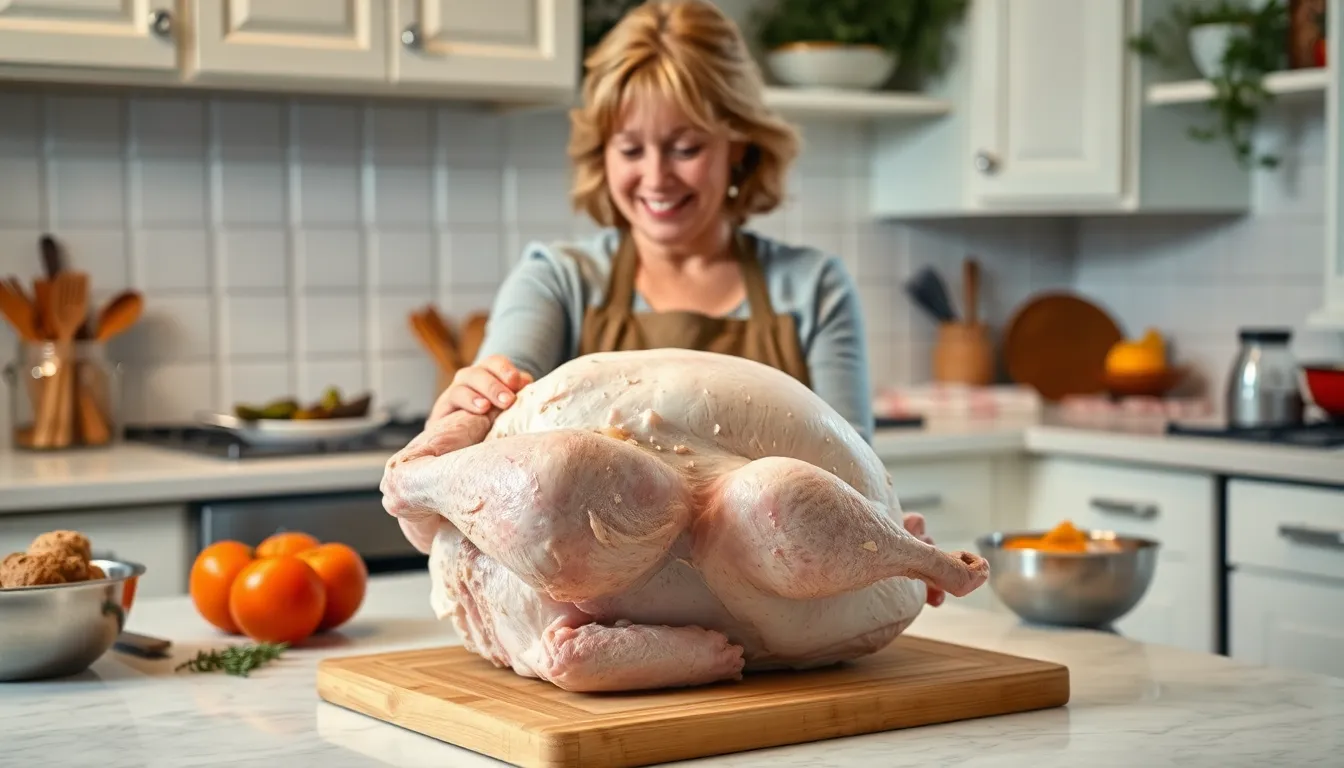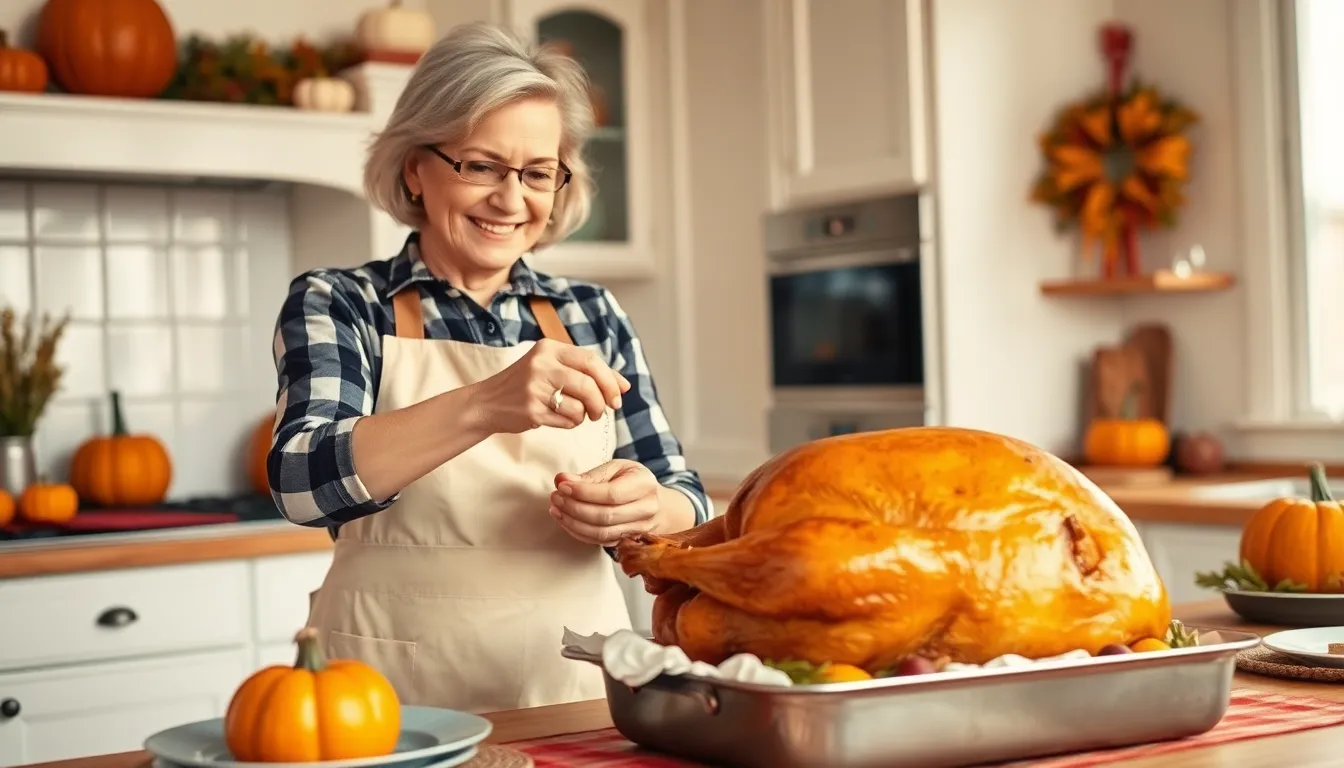Thanksgiving is just around the corner, and that means one thing: it’s turkey time! Cooking a turkey in the oven might seem like a daunting task, but it doesn’t have to be. With a sprinkle of patience and a dash of humor, anyone can turn that plump bird into a golden masterpiece worthy of a family feast.
Table of Contents
ToggleOverview of Cooking a Turkey in Oven
Cooking a turkey in the oven involves several essential steps, each contributing to an impressive dish. First, selecting a high-quality turkey is crucial. A fresh or frozen bird, typically weighing between 12 to 18 pounds, serves many guests well.
Preparing the turkey requires thorough cleaning and seasoning. Removing the giblets and rinsing the turkey under cold water ensures cleanliness. Seasoning the turkey inside and out enhances flavor. Common options include salt, pepper, garlic powder and herbs like rosemary and thyme.
Setting the oven temperature correctly is also vital. Preheating the oven to 325°F optimizes cooking. A roasting pan, ideally 2 to 3 inches deep, holds the turkey comfortably. Using a rack within the pan allows heat circulation, promoting even cooking.
Cooking times depend on the turkey size. The USDA recommends a general guideline of 13 minutes per pound for an unstuffed bird, equating to approximately 2.5 to 3 hours for an 18-pound turkey. Utilizing a meat thermometer ensures doneness with a target internal temperature of 165°F in the thickest part of the breast.
Basting may add flavor and prevent dryness. Opening the oven door to baste too frequently can prolong cooking time; as a result, limiting this practice is wise. Once fully cooked, resting the turkey for at least 20 minutes allows juices to redistribute.
Carving the turkey becomes simpler after proper resting. Slicing against the grain yields tender pieces. Minimal garnishing with fresh herbs enhances presentation. This comprehensive approach results in a juicy and flavorful turkey, elevating any Thanksgiving feast.
Preparing the Turkey

Preparing the turkey involves several important steps that ensure a delicious outcome during the feast.
Choosing the Right Turkey
Selecting the right turkey sets the stage for a successful meal. Fresh or frozen options exist, with optimal weights ranging from 12 to 18 pounds for a typical gathering. Organic or free-range turkeys often yield richer flavors. Farm-raised varieties usually contain fewer additives and enhance the dish’s quality. Sizes vary, so consider the number of guests before deciding. Look for a turkey with a plump breast and moist skin to guarantee juiciness when cooked. Checking for a sell-by date ensures freshness and quality.
Thawing the Turkey
Proper thawing is essential for food safety and cooking efficiency. When using a frozen turkey, allow 24 hours of refrigeration for every 4 to 5 pounds. This method offers a safe way to defrost while minimizing bacteria growth. Alternatively, a cold water bath speeds up thawing; submerge the turkey in water, changing it every 30 minutes. For an 18-pound turkey, this method takes about 9 hours. Always thaw the turkey completely before seasoning or cooking to ensure even heat distribution. With proper thawing, the turkey cooks evenly and remains juicy.
Seasoning and Stuffing Options
Seasoning and stuffing a turkey plays a vital role in enhancing its flavor profile. Various blends can elevate the dish to a new level of deliciousness, making it memorable for guests.
Popular Seasoning Blends
Herbs and spices create countless opportunities for flavoring turkey. Rosemary, thyme, and sage form a classic combination, lending earthy aromas. Garlic powder and onion powder add depth without overpowering the natural taste of the bird. A touch of paprika can contribute a subtle smokiness. For a hint of sweetness, consider using brown sugar or maple syrup in the mix. Many chefs also opt for ready-made blends, such as Italian seasoning or poultry seasoning, for convenience. Regardless of choice, applying seasoning under the skin ensures maximum flavor infusion.
Stuffing Recipes
Stuffing offers a chance to add texture along with flavor. Traditional bread stuffing often features cubed bread, sautéed onions, celery, and a rich broth. Adding dried fruits, such as cranberries or apricots, introduces a sweet contrast. For a hearty variation, sausage can enhance both flavor and richness. Vegetarian options exist that utilize wild rice or quinoa combined with mushrooms and nuts. One popular choice includes a cornbread base, incorporating herbs and spices for added zing. Regardless of the recipe chosen, ensuring a proper balance of moisture is crucial, as dry stuffing may detract from the experience.
Cooking Techniques
Cooking techniques for a turkey in the oven include traditional methods and options like using an oven bag. Each approach offers unique advantages that enhance the final dish.
Traditional Roasting Method
The traditional roasting method features an oven temperature set at 325°F. First, place the seasoned turkey breast side up on a roasting rack. Cooking time averages 13 minutes per pound for an unstuffed turkey. A meat thermometer inserted into the thickest part of the thigh should register 165°F to ensure safety. Basting, while occasionally beneficial, risks heat loss. Instead, consider covering the turkey loosely with foil for even browning. Resting the turkey for at least 20 minutes post-cooking preserves moisture, allowing for easier carving.
Using an Oven Bag
Using an oven bag simplifies the roasting process while locking in moisture. The turkey fits comfortably into the bag, which should be coated with seasoning beforehand. Oven bags require a slightly lower temperature of 300°F to prevent browning too quickly. Cooking times also vary, with an approximate duration of 10 to 12 minutes per pound. The bag itself helps trap steam, leading to a tender, juicy turkey. Additionally, avoiding frequent opening preserves heat and enhances overall cooking efficiency. Once finished, allow the turkey to rest before slicing, ensuring juices redistribute for optimal enjoyment.
Temperature and Timing
Understanding the right temperature and timing is crucial in cooking a turkey in the oven. A well-cooked turkey ensures a flavorful and juicy result.
Ideal Oven Temperature
Cooking a turkey at 325°F provides consistent heat for even cooking. Notably, this moderate temperature allows the turkey to roast without burning the skin. Some chefs opt for 300°F when using an oven bag, which locks in moisture while yielding tender meat. Regardless of the method, maintaining the specified temperature is essential for achieving the desired doneness.
Cooking Time Guidelines
Cooking time varies based on turkey size. For an unstuffed turkey, allocate about 13 minutes per pound. For instance, a 16-pound turkey requires approximately 208 minutes or about 3 hours and 28 minutes. Stuffed turkeys typically take longer, requiring roughly 15 minutes per pound. Checking the internal temperature at the thickest part of the thigh is critical, aiming for a final temperature of 165°F.
Testing for Doneness
Testing for doneness is crucial to ensure a safe and delicious turkey. Two primary tools facilitate this process: a meat thermometer and visual cues.
Tools for Checking Temperature
A reliable meat thermometer provides accurate internal temperature readings. Insert the thermometer into the thickest part of the thigh, avoiding contact with bone. Thermometers, whether digital or analog, offer quick results. Opt for an instant-read thermometer for efficiency, ensuring it registers an internal temperature of 165°F for doneness. Additionally, some thermometers come with alerts, removing guesswork from the process. Use this tool about 30 minutes before the turkey finishes cooking to gauge its progress.
Signs of a Fully Cooked Turkey
Several signs indicate a turkey is fully cooked beyond just temperature. Juices should run clear, not pink, when pierced near the thigh. The skin will appear golden brown, indicating proper roasting. Also, legs should move easily when wiggled, reflecting doneness. Check that the meat feels firm to the touch, confirming thorough cooking. Lastly, if it reaches 165°F with these accompanying signs, it’s ready for serving, ensuring a safe and flavorful meal.
Cooking a turkey in the oven can be a rewarding experience that brings family and friends together. With careful preparation and attention to detail, anyone can achieve a perfectly cooked turkey that stands out on the holiday table. By selecting a quality bird and following the right techniques for seasoning and cooking, the result will be a flavorful centerpiece that everyone will enjoy.
Taking the time to rest the turkey before carving ensures maximum juiciness, while thoughtful garnishing adds an appealing touch. With these tips in mind, the journey of preparing a turkey becomes less daunting and more enjoyable, making the Thanksgiving celebration truly memorable.





